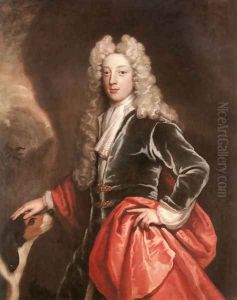John Baptist de Medina Paintings
John Baptist de Medina, also known as John Baptiste de Medina or simply Medina, was a Flemish-born portrait painter who spent a significant portion of his career in Scotland, becoming one of the country's leading portraitists in the late 17th and early 18th centuries. Born in Brussels in 1659 to a family of Spanish descent, de Medina was influenced by the Flemish painting tradition, which is reflected in his robust and vivid style.
De Medina's initial training as an artist took place in his homeland, but he soon moved to London to further his career. However, his most impactful work was done after he relocated to Scotland in 1695, where he quickly established himself as a sought-after portraitist among the Scottish gentry and nobility. In Scotland, he found a society eager to assert its status and identity, especially after the turmoil following the Acts of Union in 1707, which unified the parliaments of Scotland and England. De Medina's portraits are characterized by a grandeur that resonated with the Scottish elite's aspirations, often portraying his subjects in luxurious clothing with an air of dignity and poise.
During his time in Scotland, de Medina's influence spread, and he had a profound impact on Scottish painting. His style was a departure from the more reserved Scottish tradition, introducing a sense of drama and a bolder use of color and light. He is often credited with being a key figure in the development of the Scottish portrait painting tradition, paving the way for later artists such as Allan Ramsay and Sir Henry Raeburn.
John Baptist de Medina's success in Scotland was marked by a prolific output, and his works were in high demand. He died in Edinburgh in 1710, leaving behind a legacy that would continue to influence Scottish portraiture for generations. His portraits today are considered valuable records of the people and fashion of his time and serve as a testament to his skill and adaptability as an artist embracing a new cultural environment.
